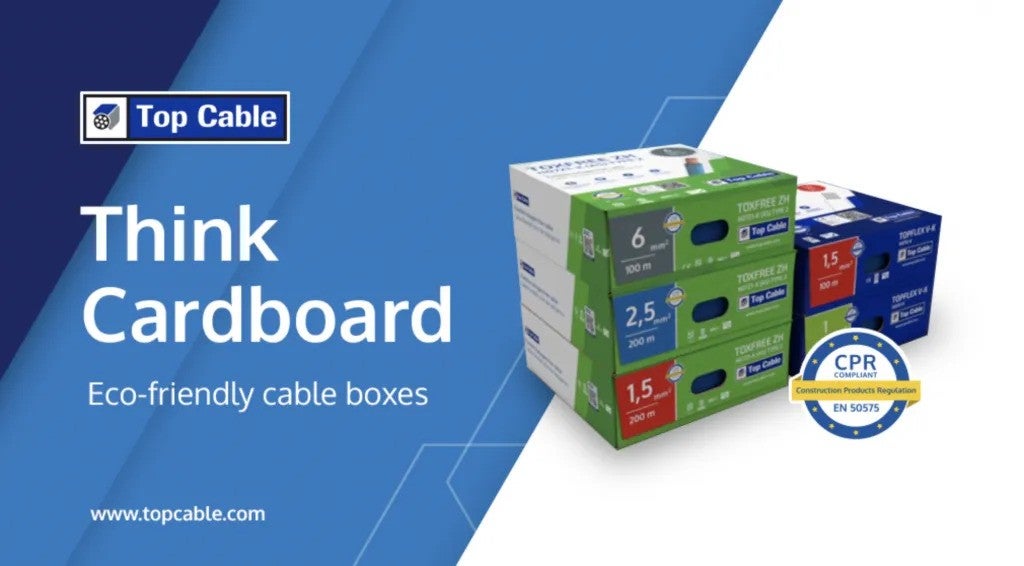
Top Cable’s sustainability strategic plan is reflected in the packaging of its products. The packaging of some of the cables from the wide range offered by the company is done using eco-friendly boxes. This approach helps to decrease the environmental impact while also streamlining the storage of electric cables due to the convenience of the recyclable boxes.
SUSTAINABLE PRODUCTION
Top Cable’s commitment to the environment is commendable in many aspects of its production chain. On one hand, there is the use of PEFC™ certified wooden drums. Additionally, the company’s commitment can be highlighted through the implementation of self-consumption-based energy supply at its locations, achieved by installing photovoltaic panels. However, it doesn’t stop there. Some of the cables produced at Top Cable are distributed in eco-friendly boxes made of recyclable cardboard.
THE ECO-FRIENDLY BOXES FROM TOP CABLE
Top Cable is committed to reducing the environmental impact in the packaging of its cables. That’s why the packaging for smaller sections of cables like Toxfree® ES05Z1-K / H07Z1-K, Topflex® H07V-K and Toxfree® Outdoor H07V-K Cu/sn (supplied in 100 or 200-meter boxes) is done using these eco-friendly boxes made of 100% recyclable and biodegradable cardboard.
The main characteristics of these boxes are as follows:
- 100% recyclable.
- Biodegradable.
- Reduced environmental impact.
- Easy access to the cable.
Recycled corrugated cardboard is just as strong and durable as cardboard made from virgin wood pulp.
ECO-FRIENDLY BOXES ADVANTATGES FOR THE ENVIRONMENT
In addition to the highlighted advantages, this production option offers many benefits for the environment. The main ones include:
- Corrugated cardboard is recyclable and biodegradable.
- Corrugated cardboard is biodegradable as it comes from renewable natural resources (trees) and fully degrades within a maximum of 1 year.
- It biodegrades faster than other materials like aluminum (10 years) or plastic (150 years), second only to organic waste.
- Corrugated cardboard is 100% recyclable. Top Cable’s cardboard boxes can be recycled up to 7 times.
- Lower environmental impact.
Corrugated cardboard has a lower environmental impact compared to other packaging materials like plastic, glass, or aluminum. Its manufacturing leads to a reduction of up to 60% in CO2 emissions and oil consumption compared to producing packaging from other materials.
Corrugated cardboard, along with paper, is the easiest material to recycle. For every ton of paper that is recycled, 2 cubic meters of landfill space, 140 liters of oil, 50,000 liters of water are saved, and up to 900 kg of carbon dioxide emissions are avoided from being released into the atmosphere.
ECO-FRIENDLY BOXES ADVANTATGES FOR ELECTRICAL CABLE DISTRIBUTORS
The benefits of the eco-friendly boxes extend beyond the environment. It also offers advantages for distributors that streamline their logistics:
- Easier organization: Due to their size and shape, the boxes are easier to stack in stores, reducing the required storage space.
- Cable sections: The boxes are available for a wide range of cable sections, each differentiated by color coding, making it easy to locate the needed cable at a glance.
- Customized colors: The boxes have a color code that allows for immediate identification of the specific cable section. There are four predetermined colors: red (1.5 mm²), blue (2.5 mm²), brown (4 mm²), and gray (6 mm²). In addition to these divisions, Top Cable also offers the option to customize the color of the boxes upon request. This option is provided to align with the specific needs of each distributor.
HALOGEN-FREE CABLES
The halogen-free cables for wiring electrical panels in places with public access are supplied in eco-friendly recyclable cardboard boxes. These cables are extra-slippery, halogen-free, flame-retardant, and emit low levels of smoke and corrosive gases in the event of a fire. They are suitable for both public and private buildings and adhere to the strictest regulations at both national and international levels, such as the Colombian RETIE or the European CPR.

